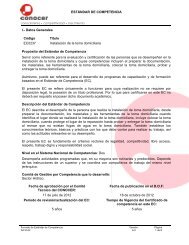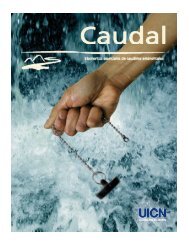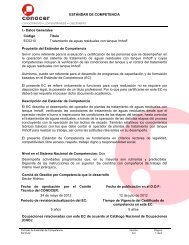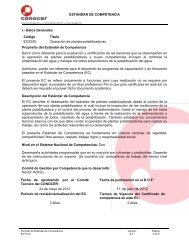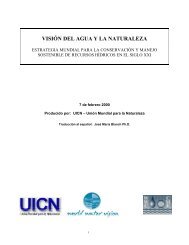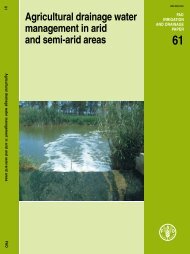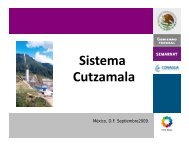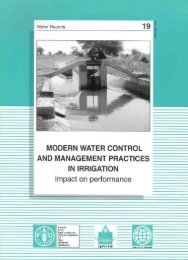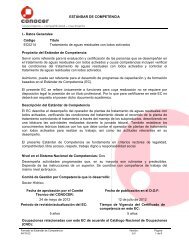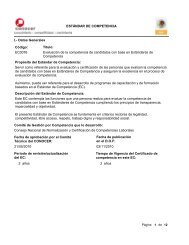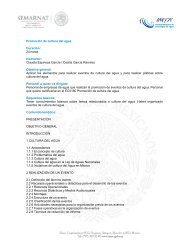An Assessment of the Status of Biodiversity in the ... - IUCN
An Assessment of the Status of Biodiversity in the ... - IUCN
An Assessment of the Status of Biodiversity in the ... - IUCN
You also want an ePaper? Increase the reach of your titles
YUMPU automatically turns print PDFs into web optimized ePapers that Google loves.
alien faunal species affect <strong>the</strong> native biodiversity as direct exploiters (ie., predators - feral cats;disease vectors - molluscs, rats and mice) and superior competitors for resources (ie., Tilapia).As mentioned earlier, 9 <strong>in</strong>vasive alien plant species were also documented from Maduganga.The terrestrial <strong>in</strong>vaders <strong>in</strong>clude <strong>An</strong>nona glabra, Swietenia macrophylla, Alstonia macrophylla,Chromolaena odorata, and Lantana camara, while <strong>the</strong> aquatic <strong>in</strong>vaders <strong>in</strong>clude Eichhorniacrassipes, Salv<strong>in</strong>ia molesta, Hydrilla verticillata and Najas mar<strong>in</strong>a. Of <strong>the</strong>se <strong>in</strong>vasive plants,<strong>An</strong>nona glabra, Hydrilla verticillata and Najas mar<strong>in</strong>a have spread <strong>in</strong>to many places <strong>in</strong>Maduganga. Unfortunately, <strong>the</strong> spread <strong>of</strong> <strong>An</strong>nona glabra has been facilitated by members <strong>of</strong> alocal NGO <strong>in</strong> Maduganga, who have used this species for replant<strong>in</strong>g purposes. Accord<strong>in</strong>g tolocal fishermen, <strong>the</strong> two submerged <strong>in</strong>vaders - Hydrilla verticillata and Najas mar<strong>in</strong>a haveentered Maduganga about 4-5 years ago. It is possible that <strong>the</strong> accumulation <strong>of</strong> nutrients(through agricultural run<strong>of</strong>f, and discharge <strong>of</strong> organic wastes) <strong>in</strong> <strong>the</strong> estuary may have led to<strong>the</strong> proliferation <strong>of</strong> <strong>the</strong>se two species.The <strong>in</strong>vasive alien plants form thickets and shades out native vegetation, and <strong>the</strong>reby displace<strong>the</strong>m gradually. At <strong>the</strong> extreme level, <strong>the</strong> <strong>in</strong>vasive alien plants may entirely modify <strong>the</strong> structureand function <strong>of</strong> an ecosystem, which could occur <strong>in</strong> many ways. For <strong>in</strong>stance, <strong>the</strong> <strong>in</strong>vasiveplant species can produce substances that are toxic to o<strong>the</strong>r native plant species (allelopathicsubstances) and <strong>the</strong>reby make <strong>the</strong> soil unsuitable for <strong>the</strong> orig<strong>in</strong>al native plant communities.The aquatic <strong>in</strong>vasive alien plants that form dense mats (ie., Float<strong>in</strong>g species such as Salv<strong>in</strong>iamolesta and Eichhornia crassipes and submerged species such as Najas mar<strong>in</strong>a and Hydrillaverticillata) tends to accumulate greater amount <strong>of</strong> sediment. In addition, species such asSalv<strong>in</strong>ia, Eichhornia and <strong>An</strong>nona results <strong>in</strong> high loss <strong>of</strong> water through <strong>in</strong>creased transpiration,result<strong>in</strong>g <strong>in</strong> gradual conversion <strong>of</strong> wetland <strong>in</strong>to terrestrial habitats. Fur<strong>the</strong>rmore, <strong>the</strong> dense mats<strong>of</strong> aquatic <strong>in</strong>vasive plants leads to drastic fluctuations <strong>of</strong> dissolved oxygen, hence affect<strong>in</strong>g <strong>the</strong>aquatic fauna. The f<strong>in</strong>al outcome <strong>of</strong> such uniform stands <strong>of</strong> <strong>in</strong>vasive alien plants is <strong>the</strong>narrow<strong>in</strong>g down <strong>of</strong> native biological diversity <strong>in</strong> a particular locality.Threatened areas <strong>of</strong> MadugangaThe threats discussed above were assessed at <strong>the</strong> different sampl<strong>in</strong>g strata <strong>of</strong> <strong>the</strong> Madugangawetland, and <strong>the</strong> results are presented <strong>in</strong> Table 7. When consider<strong>in</strong>g <strong>the</strong> threats accord<strong>in</strong>g tooverall habitat degradation, direct exploitation <strong>of</strong> species, spread <strong>of</strong> <strong>in</strong>vasive alien species andhuman population pressure, a few <strong>in</strong>terest<strong>in</strong>g features are evident <strong>in</strong> <strong>the</strong> six predeterm<strong>in</strong>edsampl<strong>in</strong>g strata <strong>of</strong> Maduganga. For <strong>in</strong>stance, consider<strong>in</strong>g <strong>the</strong> overall status <strong>of</strong> habitatdegradation, <strong>the</strong>re is an <strong>in</strong>crease from <strong>the</strong> upper to lower areas <strong>of</strong> Maduganga, correspond<strong>in</strong>gto an <strong>in</strong>crease <strong>in</strong> human population density. Conversely, illegal activities related to directexploitation <strong>of</strong> species (ie., poach<strong>in</strong>g) is high <strong>in</strong> upper areas <strong>of</strong> Maduganga, and decreasestowards lower areas. Similarly, <strong>the</strong> threats related to <strong>the</strong> spread <strong>of</strong> <strong>in</strong>vasive alien species ismoderate to high <strong>in</strong> <strong>the</strong> upper reaches, compared to <strong>the</strong> lower areas <strong>of</strong> Maduganga. It isalarm<strong>in</strong>g to note that <strong>the</strong> upper reaches <strong>of</strong> Maduganga, which was found to be <strong>the</strong> region <strong>of</strong>high ecological significance, is threatened by direct exploitation <strong>of</strong> species as well as <strong>the</strong>spread <strong>of</strong> <strong>in</strong>vasive alien species.17



